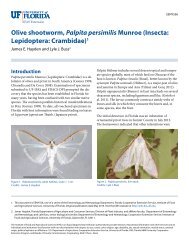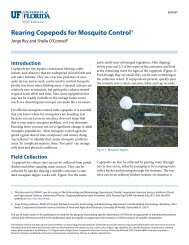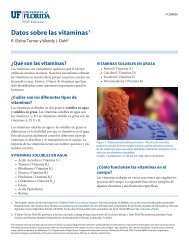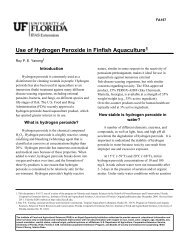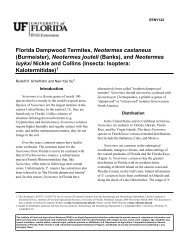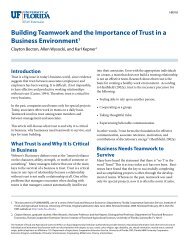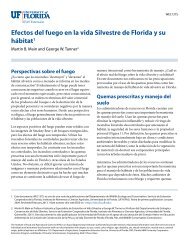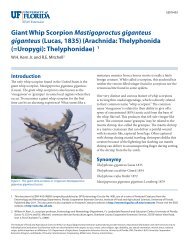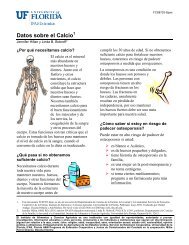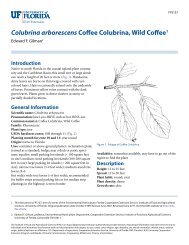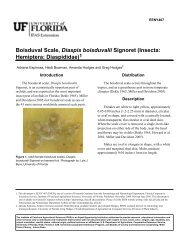Puss Caterpillar (Larva), Southern Flannel Moth (Adult ...
Puss Caterpillar (Larva), Southern Flannel Moth (Adult ...
Puss Caterpillar (Larva), Southern Flannel Moth (Adult ...
Create successful ePaper yourself
Turn your PDF publications into a flip-book with our unique Google optimized e-Paper software.
Figure 29. <strong>Southern</strong> flannel moth pupal exuviae, Megalopyge<br />
opercularis.<br />
Credits: Donald W. Hall, University of Florida.<br />
Economic and Medical Improtance<br />
Occasionally, in outbreak years, puss caterpillars are sufficiently<br />
numerous to defoliate some trees (Bishopp 1923).<br />
However, their main importance is medical. In Texas,<br />
they have been so numerous in some years that schools in<br />
San Antonio in 1923 and Galveston in 1951 were closed<br />
temporarily because of stings to children (Diaz 2005).<br />
The venomous spines of puss caterpillars are hollow and<br />
each is equipped with a venom gland at its base (Foot<br />
1922). All larval instars, as well as exuviae, may sting but<br />
the toxicity of the stings increases with increasing size of<br />
the larvae (Davidson 1967).<br />
Figure 30. <strong>Puss</strong> caterpillar, Megalopyge opercularis (early instar<br />
showing venomous spines).<br />
Credits: Donald W. Hall, University of Florida.<br />
Figure 31. <strong>Puss</strong> caterpillar, Megalopyge opercularis (pre-pupa showing<br />
venomous spines).<br />
Credits: Donald W. Hall, University of Florida.<br />
Foot (1922) reported that some individuals react more<br />
severely to stings than others, and the severity of the sting<br />
varies with the thickness of the skin where the sting occurs<br />
The sting produces an immediate intense burning pain<br />
followed by the appearance of a red grid-like pattern on the<br />
skin that matches the pattern of the venomous spines on<br />
the caterpillar. Swelling and sometimes also lymphadenopathy<br />
follow.<br />
In addition to the characteristic localized symptoms, more<br />
general systemic manifestations may also occur including<br />
headache, fever, nausea, vomiting, tachycardia, low blood<br />
pressure, seizures and more rarely, abdominal pain, muscle<br />
spasms and convulsions (Diaz 2005, Eagleman 2008, El-<br />
Mallakh et al. 1986, Hossler 2010, McGovern 1961, Pinson<br />
and Morgan 1991).<br />
Figure 32. <strong>Puss</strong> caterpillar, Megalopyge opercularis (characteristic<br />
pattern of sting).<br />
Credits: Courtesy of Armed Forces Pest Management Board.<br />
The venom is not well-characterized but it has been shown<br />
to possess hemolytic activity, and there is evidence that<br />
it is proteinaceous based primarily on its precipitation by<br />
75% saturated ammonium sulfate and the fact that it is<br />
inactivated by digestion with proteolytic enzymes (trypsin,<br />
pepsin, or chymotrypsin) (Picarelli and Valle 1971).<br />
Eagleman (2008) has reviewed common treatments for puss<br />
caterpillar stings. Remedies that may be helpful in some<br />
cases include removing broken spine tips from the skin<br />
with tape, applying ice packs, use of oral antihistamine,<br />
application of hydrocortisone cream to the site of the<br />
sting, systemic corticosteroids, and intravenous calcium<br />
gluconate.<br />
8



